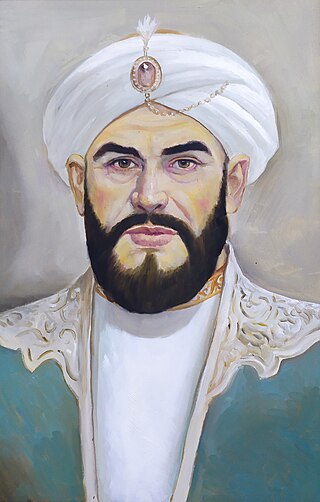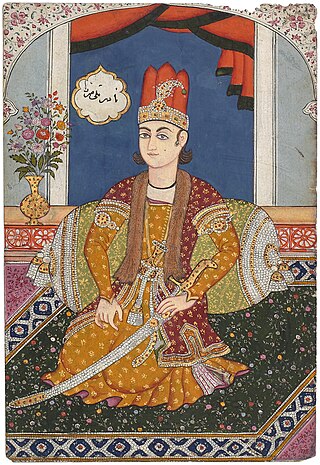
Khwarazm or Chorasmia is a large oasis region on the Amu Darya river delta in western Central Asia, bordered on the north by the (former) Aral Sea, on the east by the Kyzylkum Desert, on the south by the Karakum Desert, and on the west by the Ustyurt Plateau. It was the center of the Iranian Khwarezmian civilization, and a series of kingdoms such as the Afrighid dynasty and the Anushtegin dynasty, whose capitals were Kath, Gurganj and—from the 16th century on—Khiva. Today Khwarazm belongs partly to Uzbekistan and partly to Turkmenistan.

Shahrokh Mirza, better known by his dynastic title of Shahrokh Shah was the Afsharid king (shah) of the western part of Khorasan from 1748 to 1796, with a two-month interruption. A grandson of the Iranian conqueror Nader Shah, Shahrokh was the son of Reza Qoli Mirza Afshar and his Safavid wife Fatemeh Soltan Begom, who was the sister of Tahmasp II, the penultimate Safavid shah of Iran. Shahrokh's half-Safavid descent made him stand out amongst his Afsharid relatives, and was used to bolster the legitimacy of his grandfather. After the assassination of Nader Shah in 1747, his nephew Ali-qoli Khan, ascended the throne in Mashhad and had all of Nader Shah's descendants in fortress of Kalat massacred. Shahrokh was spared in case his Safavid lineage would come to use, and was instead kept in the fortress as a prisoner. While Adel Shah was battling his rebellious younger brother Ebrahim Mirza, a party of Turkic, Kurdish, and Arab tribal leaders took advantage of his absence and installed Shahrokh on the throne. Both Adel Shah and Ebrahim were eventually defeated and killed, but Shahrokh was not long afterwards overthrown by a party of dissident tribal leaders, who installed the Safavid pretender Mir Sayyed Mohammad on the throne. Shahrokh was soon blinded at the instigation of Mir Alam Khan Khuzayma and other leading nobles, much against Suleiman II's will.

The Khanate of Khiva was a Central Asian polity that existed in the historical region of Khwarazm from 1511 to 1920, except for a period of Afsharid occupation by Nader Shah between 1740 and 1746. Centred in the irrigated plains of the lower Amu Darya, south of the Aral Sea, with the capital in the city of Khiva. It covered present-day western Uzbekistan, southwestern Kazakhstan and much of Turkmenistan before the Russian conquest at the second half of the 19th century.

The Emirate of Bukhara was a Muslim-Uzbek polity in Central Asia that existed from 1785 to 1920 in what is now Uzbekistan, Tajikistan, Turkmenistan and Kazakhstan. It occupied the land between the Amu Darya and Syr Darya rivers, known formerly as Transoxiana. Its core territory was the fertile land along the lower Zarafshon river, and its urban centres were the ancient cities of Samarqand and the emirate's capital, Bukhara. It was contemporaneous with the Khanate of Khiva to the west, in Khwarazm, and the Khanate of Kokand to the east, in Fergana. In 1920, it ceased to exist with the establishment of the Bukharan People's Soviet Republic.

The Khanate of Bukhara was an Uzbek state in Central Asia from 1501 to 1785, founded by the Abu'l-Khayrid dynasty, a branch of the Shaybanids. From 1533 to 1540, Bukhara briefly became its capital during the reign of Ubaidullah Khan. The Khanate reached its greatest extent and influence under its penultimate Abu'l-Khayrid ruler, the scholarly Abdullah Khan II.

Ali-qoli Khan, commonly known by his regnal title Adel Shah was the second shah of Afsharid Iran, ruling from 1747 to 1748. He was the nephew and successor of Nader Shah, the founder of the Afsharid dynasty.

Abu al-Ghazi Bahadur was the Khan of Khiva from 1643 to 1663. He was a member of the Uzbek Shaybanid dynasty. He spent ten years in Persia before becoming khan, and was very well educated, writing two historical works in the Khiva dialect of the Chagatai language. He was a descendant of Genghis Khan through Arab Shah.

The Manghud, or Manghit were a Mongol tribe of the Urud-Manghud federation. Manghuds who moved to the Desht-i Qipchaq steppe were Turkified. They established the Nogai Horde in the 14th century and the Manghit dynasty to rule the Emirate of Bukhara in 1785. They took the Islamic title of Emir instead of the title of Khan, since they were not descendants of Genghis Khan and rather based their legitimacy as rulers on Islam. However, Persian historian Rashid-al-Din Hamadani who chronicled the Mongols, claimed that many old Mongolian clans were founded by Borjigin members. The clan name was used for Mongol vanguards as well. Members of the clan live in several regions of Central Asia and Mongolia.

Nader Shah Afshar was the founder of the Afsharid dynasty of Iran and one of the most powerful rulers in Iranian history, ruling as shah of Iran (Persia) from 1736 to 1747, when he was assassinated during a rebellion. He fought numerous campaigns throughout the Middle East, the Caucasus, Central Asia, and South Asia, such as the battles of Herat, Mihmandust, Murche-Khort, Kirkuk, Yeghevārd, Khyber Pass, Karnal, and Kars. Because of his military genius, some historians have described him as the Napoleon of Persia, the Sword of Persia, or the Second Alexander. Nader belonged to the Turkoman Afshars, one of the seven Qizilbash tribes that helped the Safavid dynasty establish their power in Iran.
The history of Bukhara stretches back millennia. The origin of its inhabitants goes back to the period of Aryan immigration into the region. The city itself, currently the capital of the Bukhara Region (viloyat) of Uzbekistan, is about two and a half thousand years old. Located on the Silk Road, the city has long been a centre of trade, scholarship, culture, and religion. During the Golden age of Islam, under the rule of Samanids, Bukhara became the intellectual centre of the Islamic world. In medieval times, Bukhara served as the capital of the Khanate of Bukhara and was the birthplace of Imam Bukhari.

Iranian Turkmens are a branch of Turkmen people living mainly in northern and northeastern regions of Iran. Their region is called Turkmen Sahra and includes substantial parts of Golestan Province of Iran. The number of Turkmens in Iran is estimated at 0.5 to 2.4 million people.

Reza Qoli Mirza Afshar was the eldest son of Nader Shah, King of Afsharid Iran. After his father's coronation in 1736, Reza Qoli, aged 17, became the Governor of the province of Khorasan. During his tenure, he subdued rebellious khans and marched up to Bukhara to put an end to the Khanate of Bukhara, his father's enemies. Before heading off to India, Nader Shah appointed Reza Qoli the regent of Iran. Reza Qoli ensured peace through harsh measures when collecting taxes and executed people for petty crimes. He had Tahmasp II and Abbas III, two pretenders to the throne, killed, which caused an uproar among the people. When Nader Shah returned from India, he dismissed Reza Qoli as regent, snubbing him for his actions during the regency.

After Nader Shah was assassinated in 1747, his nephew Ali Qoli seized the throne and proclaimed himself Adil Shah. He ordered the execution of all Nader's sons and grandsons, with the exception of the 13-year-old Shahrokh, the son of Reza Qoli.
Abu al-Fayz Khan was the Janid ruler of the Khanate of Bukhara from 1711 to 1747. It was during the rule of Abu al-Fayz Khan that Janid rule lost its authority in the khanate of Bukhara.

The Guarded Domains of Iran, commonly referred to as Afsharid Iran or the Afsharid Empire, was an Iranian empire established by the Turkoman Afshar tribe in Iran's north-eastern province of Khorasan, establishing the Afsharid dynasty that would rule over Iran during the mid-eighteenth century. The dynasty's founder, Nader Shah, was a successful military commander who deposed the last member of the Safavid dynasty in 1736, and proclaimed himself Shah.
The Maimana Khanate was an Uzbek Khanate in Northern Afghanistan centered around the town of Maimana. It was founded in 1747 with the death of Nader Shah. The Mings had been the governors of Maimana since 1621. Hajji Bi Ming was the first independent ruler of the khanate. After the death of Ahmad Khan in 1814, Sar-i Pul seceded from the khanate. In the 1830s Sar-i Pul took the district of Gurziwan from Maimana. The Aimaq tribes of the Murghab broke away from Maimana by 1845. In 1847 and 1850 it resisted attempts by the Emirate of Herat to annex it. In 1875 the khanate rebelled against Afghanistan but it was crushed and the city sacked. In 1892 the khanate was annexed by Afghanistan.
The Qajar Principality of Merv was an independent principality that existed in Central Asia from c.1747 to 1788. It was ruled by the 'Izz al-Dinlu clan of the Qajars of Merv, who had been governors of the oasis since Safavid times. It gained its independence after the death of Nader Shah in 1747 and had good relations with the ruler of Bukhara, Daniyal Biy. When his son, Shah Murad took over in 1785, he launched a campaign that killed the ruler of the principality, Bayram 'Ali Khan Qajar. By 1788 the entire oasis was conquered and annexed to Bukhara. The last ruler, Mohammad Husayn Khan, fled to Iran.

Nadir Shah Afshar's capture of Samarkand, one of the political and economic centers of the region, during his Central Asian campaign. According to Nader Shah, who was an admirer of Amir Timur, Samarkand had a symbolic meaning. The capture occurred in 1740 and Nader Shah entered Samarkand almost unopposed. According to legend, Nader Shah brought the double doors of the Bibi-Khanym Mosque made of gold, silver, precious stones, jewelry and other precious metals, located in Samarkand, as well as a number of architects, artists, and scientists, to the center of the Afshar Empire.

The Battle of Pitnak was fought in 1740 between Nader Shah and Ilbars Khan II, the ruler of the Khiva Khanate. Fought in Pitnak, now in Uzbekistan, the battle took place within the framework of Nader's Central Asian campaign.
Ubaidullah Khan was the 4th Shaybanid Khan of Bukhara, who ruled between 1534 and 1539. He was the son of Mahmud and nephew of Muhammad Shaybani, founder of the Shaybanid dynasty.















